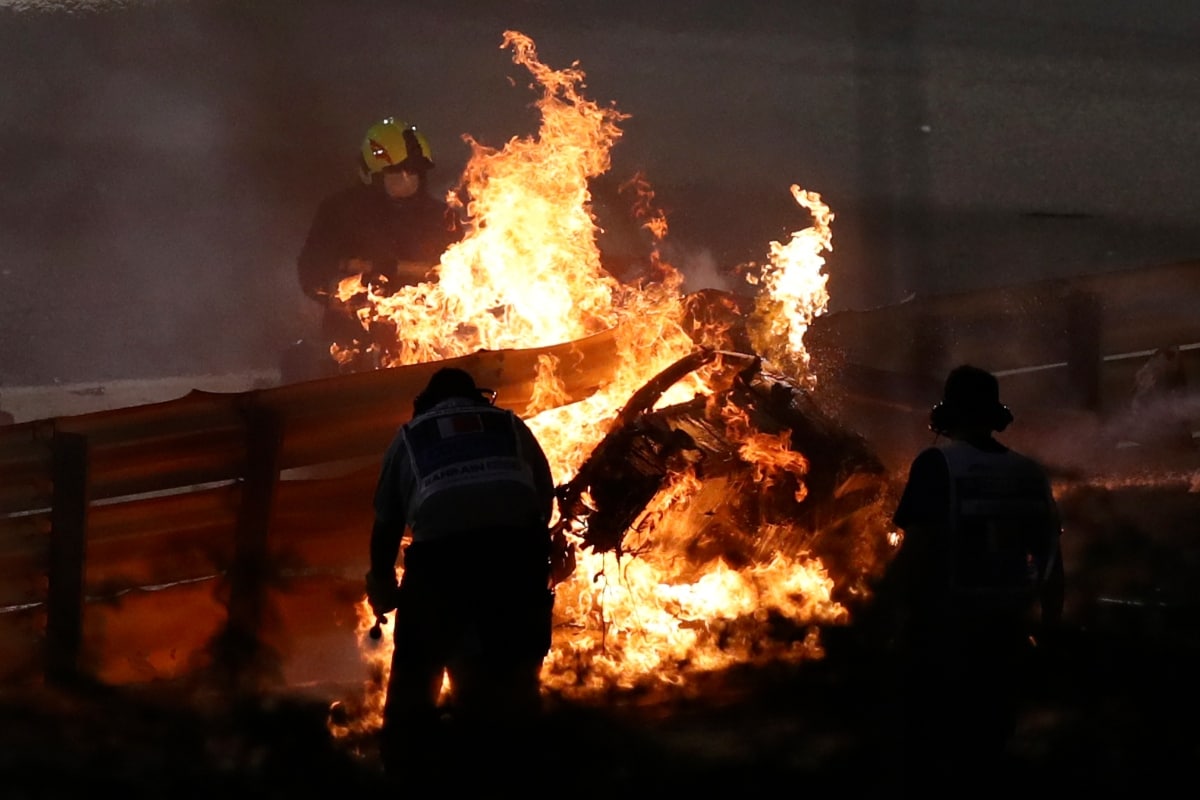Romain Grosjean survived a horrific crash miraculously on Sunday during the Bahrain Grand Prix as he emerged out of a burning car with only minor burns on his fingers. He did not have a single broken bone as walked into the ambulance after a car-splitting crash, that is a first since one in Monaco in 1991, according to BBC. Grosjean’s car veered off the track and rammed straight into the crash barrier, which split it into two. The split car immediately caught fire but Grosjean managed to limp out of it with the help of the Chief Medical officer and the Medical car driver.
Grosjean reportedly braked the car when it was going on at approximately 215kmph and the estimated impact speed was 200kmph. The impact was measured at a force of 53G. In terms of how the crash looked like, it was perhaps the worst Formula One has seen in a long time. Yet, Grosjean survived without much damage and F1’s halo system is being credited for the same.
ALSO READ | Had a Small Window of Opportunity to Rescue Grosjean, Says F1 Medical Delegate
WHAT IS THE HALO SYSTEM?
The halo is a curved bar made of titanium placed on the car’s cockpit as a protection system for the driver’s head. It is connected to the vehicle’s frame by three points. In its version in 2016, the halo weighed 7kgs but it rose to 9kgs in 2017.
Screengrab from F1 YouTube channel.
The halo is not developed by the teams but by three external manufacturers approved by International Automobile Federation (FIA) and the specifications of the system are the same for all the vehicles.
Under simulation performance by the FIA using the data of 40 real incidents, the halo led to a 17 per cent increase in the survival rate of the driver in theory.

In 2018, FIA made it mandatory for all vehicles to have the halo system installed in Formula 1, Formula 2, Formula 3 and Formula E.
ALSO READ | Former Sceptic Romain Grosjean Praises Halo After Surviving Crash
HALO THE SAVIOUR
The halo system was initially not received well with many saying it takes away the essence of racing. It was considered as an obstruction in the vision of the driver and also made the cars heavier, which meant the teams had to shed weight from their car designs.
The current Formula One champion Lewis Hamilton was also initially opposed to the halo system and called it “the worst looking modification in Formula 1 history” back in Barcelona in 2016.
However, after Sunday’s accident, Hamilton admitted to the effects of halo and said, “I don’t know what Gs he pulled, but I am just so grateful that the halo worked… It shows what an amazing job Formula One has done, the FIA has done, for him (Grosjean) to be able to walk away from something like that.”
Grosjean himself hated the halo system initially. Back in 2017, when the system was being tested, Grosjean said he “hated it” and it made him “feel sick”. From the hospital bed after the crash, though, Grosjean said, “I wasn’t for the halo some years ago, but I think it’s the greatest thing that we’ve brought to Formula 1, and without it I wouldn’t be able to speak with you today.”
On Sunday, Red Bull driver Max Verstappen also said, “I think the halo saved his (Grosjean’s) life. When it came onto the cars I was quite critical about it and it looked ugly. But you can’t say anything about the safety because today it definitely saved Roman.”
Over the two years, halo has been credited for shielding the drivers’ during accidents like:
— Formula Two race at Catalunya, where Tadasuke Makino’s halo was landed on by fellow countryman Nirei Fukuzumi’s car
— Belgian Grand Prix in 2018 where Charles Leclerc’s halo was struck by Fernando Alonso’s airborne McLaren, with both of their haloes showing visible damage from the impact.
— A crash involving Alex Peroni during a Formula 3 event at Monza on September 7, 2019, when his vehicle went airborne.

